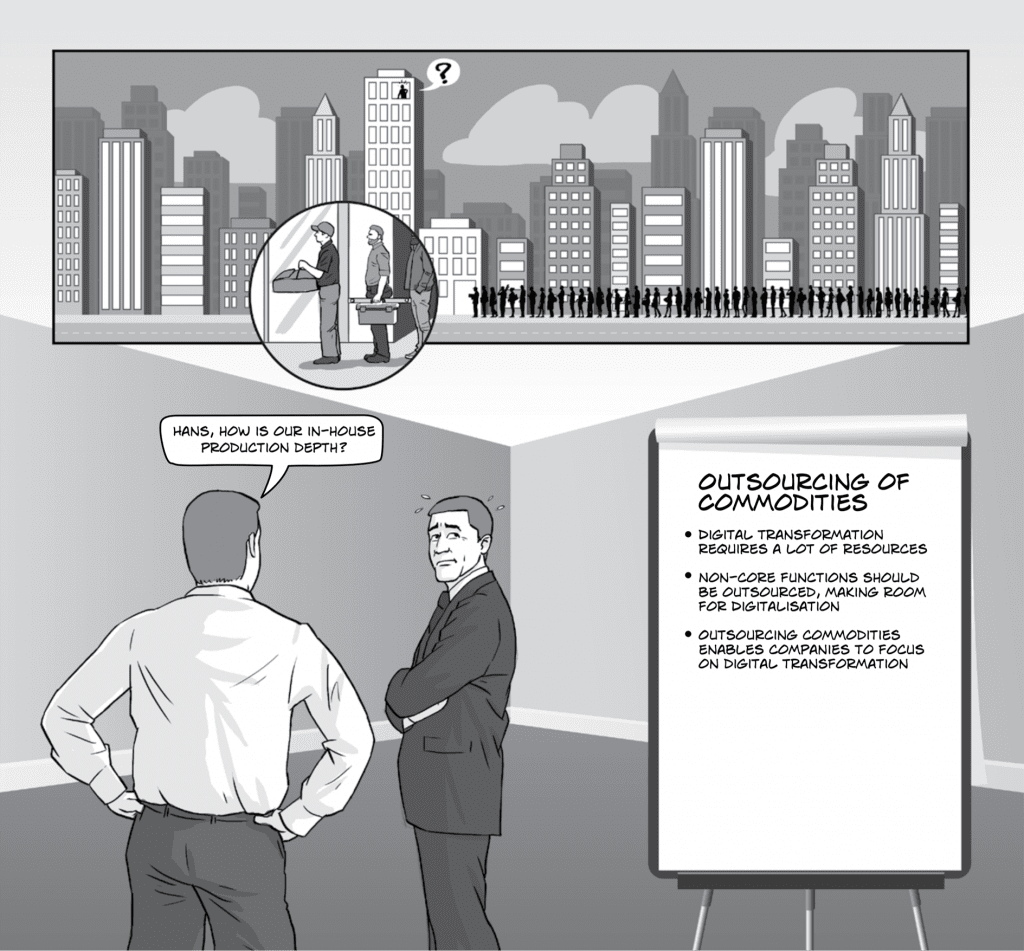There are a host of issues to be aware of on your way to becoming a digital enterprise. The most important is your current reality. It continues to consume resources, which you should target on becoming a digital enterprise instead of maintaining your status quo. Capacity must be freed up to redirect the organisation’s focus on the complex task of digitalisation, which has many facets.
Firstly, there is the issue of people:
you need to supply sufficiently skilled resources to reach your digital goals.
This usually means more headcount is required. And a major digital change programme will most likely create uncertainty and maybe even fear among your staff. This often means decreased efficiency or even open opposition within your teams.
Your company’s IT is another source of potential headaches. Depending on your industry, your company may have been pressed to make major savings in previous years – it is not unlikely that under such circumstances your IT is currently unfit for any of the challenges digitalisation brings with it.
In addition, maintaining the IT of the past blocks the resources needed to create the IT necessary for the digital era.
And it focuses too many decision makers on past technology, thus blocking the brainpower needed to think about the future.
Finally, the limits to management capacity should be on your list of issues.
Everything your company does requires energy, investment and management attention.
If we assume that all of these resources are limited, focusing them on the past is a waste of resources – at least with regard to becoming a digital enterprise. In addition, many services you provide internally may have lost their competitiveness due to the fact that a changing services marketplace could allow you to outsource them more competitively from others.
You need to ensure your whole company is focused on digitalisation. One must not underestimate the need also to focus management attention on the topic of digitalisation rather than on delivering and fixing ‘classical’ support processes. Take fintech start-ups as a guiding star: they gain tremendous development speed by outsourcing to the extreme. The start-up management can then focus on building the digital business model. Similarly, management capacity must be released to shape and execute the digitalisation process.
Any activity not contributing directly to digitalisation is a distraction.
One way of reducing that is to consider outsourcing all commodity[1] services (such as email, ERP, IT infrastructure) that are currently supplied internally.
Outsourcing[2] is also a great opportunity to revisit the services consumed by your company. Consider that a) even if you only have one customer left, the whole infrastructure has to work, b) any changes (even necessary ones) are generating huge costs, while there is little to no profit, and c) old IT services can rarely be scaled down.
Many elements within a business have to become flexible and agile. That means capital is not as bound by investment and planning as was previously the case. Generally speaking, capital expenditure (CAPEX) must be converted into flexible operational expenditure (OPEX), which allows for agile spending changes. You need to opt for ‘pay-as-you-go’ solutions wherever you can. Only pay for services where needed and scale them up or down as you need them.
This maximised flexibility is urgently needed to cope with increased market volatility and shorter product and innovation life cycles. From an IT perspective, short iteration cycles will be an absolute must. Otherwise, your business will not be able to react to changes or opportunities in your market. Unfortunately, current enterprise IT – both from an organisational standpoint and from an infrastructural standpoint – is often not ft for such challenges. If you have to keep certain parts of your IT in-house (e.g., because you built certain applications yourself for competitive reasons), spend time understanding agile development and operations (DevOps). This approach may help you to become more agile.
Digital businesses have very different dynamics relative to IT demand than traditional businesses. For example, the IoT and Industry 4.0 create enormous amounts of data, previously unheard of.
Digitalisation often also means mobility.
Traditionally, IT departments have struggled to cope with mobile solutions; security concerns and challenges in managing the number of desired mobile devices were usually the key blocking point. In the digital era, this needs to be overcome. Digitalisation connects everything within a company and also companies with each other. Thus, it is necessary for a company’s transformation process to cover all departments.
It is not sufficient to implement digitalisation within the company’s IT department, while other divisions or departments are not able to make use of it due to a lack of transformation. Unfortunately, not all parts of your business will transform easily. As highlighted above, one solution is to outsource the commodity parts of your business to free up enough management power and time to change those complicated parts of your company.
There may have been very good reasons for the way your company provides internal services today. But consider this: many services a typical company provides internally (e.g., IT or HR) can be outsourced as commodities today. Additionally, services such as email that may have needed extensive individualisation years ago can now be sourced pretty much off the shelf.
Check all your internal services one by one and ask yourself: do we do this internally for a business reason? Or do we do this internally because we always have? Which of these services is part of our core business and crucial to digitalisation? Could we source any of these services from specialised vendors, lowering cost and making our overheads for that service more flexible by changing to a pay-as-you-go model? Here is a short summary of why a business should (or should not) outsource commodities:
Effective outsourcing does require close provider management and hence the enterprise has to attract appropriate managerial skills, which are seldom found in a vertically integrated organisation. But rapidly following the invention of outsourcing came the provision of consulting support on best practice outsourcing, which is readily available on the market.
_____
[1] Garbe, G. , Hausen, T.: ‘Process Commodities: Entwicklung eines Reifegradmodells als Basis für Outsourcingentscheidungen’, Work reports from the Department of Computer Science, University of Koblenz-Landau, Vol. 8, 2009.
[2] Gouge, I.: ‘Shaping the IT Organization – The Impact of Outsourcing and the New Business Model’, p. 139ff, Springer Verlag London Limited, 2003.


